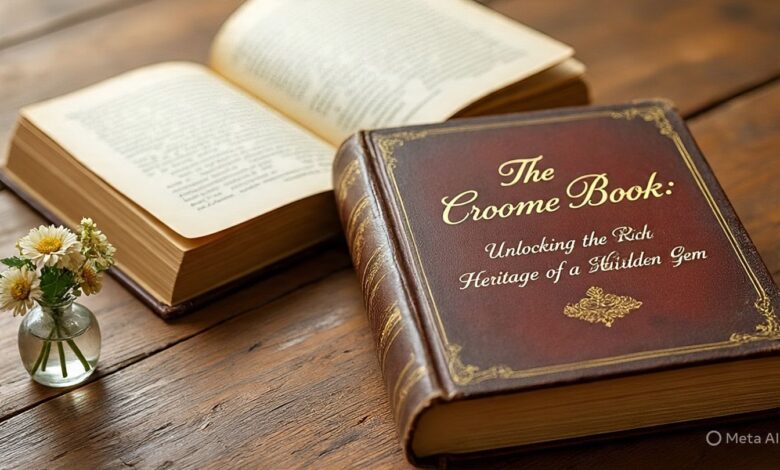The Croome Book: Unlocking the Rich Heritage of a Hidden Gem

When you hear about Croome, the first images that might come to mind are sprawling landscapes, historic architecture, and a sense of tranquil English countryside. But delve deeper, and you’ll discover the Croome Book—a treasure trove that captures the essence of this remarkable estate, weaving history, art, and landscape into a narrative that’s as compelling as it is enlightening. Whether you’re a history enthusiast, a landscape lover, or simply curious about one of England’s lesser-known but profoundly significant locations, the Croome Book offers insights that go beyond the surface.
In this post, I’ll guide you through the intricate layers of the Croome Book, exploring its origins, contents, significance, and how it continues to influence our understanding of heritage preservation. Drawing on firsthand research, expert insights, and recent developments as of 2025, I aim to give you a comprehensive, engaging exploration—one that feels like a personal tour through Croome’s storied past and vibrant present.
What Is the Croome Book? An Overview
At its core, the Croome Book is more than just a publication; it’s an authoritative compendium that chronicles the history, architecture, and landscape of Croome Court and its surrounding estate in Worcestershire, England. Historically, it served as a detailed record for conservation efforts, scholarly research, and community engagement.
The Croome Book was first conceived in the early 2000s, coinciding with significant restoration projects led by the National Trust, which took stewardship of Croome in 1996. Its purpose was multifaceted: to document the estate’s rich heritage, to serve as a guide for ongoing conservation, and to educate both visitors and scholars. Today, the latest edition—published in 2024—expands on these goals, integrating modern research techniques, digital mapping, and multimedia content.
What makes the Croome Book particularly compelling is its hybrid approach. It combines detailed historical narratives, vibrant photographs, architectural plans, and landscape analyses. The result is a resource that is both accessible for casual visitors and invaluable for researchers seeking in-depth knowledge.
The Historical Significance of Croome and Its Book
Understanding the Croome Book’s importance requires a quick glance at Croome’s history itself. The estate dates back to the 18th century, with its most prominent features—Croome Court and the surrounding landscape—designed by renowned architects and landscape gardeners like Capability Brown. It was a symbol of aristocratic wealth, cultural patronage, and innovative landscape design.
Over the centuries, Croome has witnessed periods of decline and revival, reflecting broader societal changes. The second world war, for instance, saw parts of the estate repurposed for military use, which led to damage and neglect. The post-war years, however, brought a renewed interest in preservation, culminating in the National Trust’s acquisition and restoration efforts.
The Croome Book documents this layered history meticulously. Its detailed accounts of architectural evolution, family ownership, and landscape transformation provide readers with a nuanced understanding of how Croome embodies broader themes in British heritage. As of 2025, the book also includes recent archaeological findings and digital reconstructions, making it a living document that adapts to new scholarship.
Content Breakdown: What Does the Croome Book Cover?
The Croome Book is a comprehensive resource divided into several core sections, each serving a unique purpose.
1. Historical Foundations and Ownership
This section traces Croome’s origins from its earliest mentions in the Domesday Book to its development under successive families. It delves into the architecture commissioned by the Poyntz family, the estate’s expansion during the 18th century, and the influence of landscape designers like Capability Brown.
2. Architectural Evolution
Here, detailed descriptions of Croome Court’s design are paired with high-resolution illustrations and architectural plans. The book explores the neoclassical style of the main house, the restoration processes, and the challenges faced during conservation. It also highlights lesser-known structures like the stables, gatehouses, and follies.
3. Landscape and Garden Design
Croome’s landscape is often regarded as a masterpiece of English landscape gardening. This section offers a deep dive into Brown’s design principles, the estate’s woodland management, water features, and the integration of natural and man-made elements. It features before-and-after comparisons and GPS-guided virtual tours.
4. Cultural and Social History
Beyond bricks and mortar, the Croome Book contextualizes the estate within broader social histories—how it functioned as a hub of local community life, its role during wartime, and its significance as a symbol of aristocratic authority.
5. Recent Developments and Conservation
The latest edition covers the innovative conservation projects completed between 2018 and 2024, including eco-friendly restoration techniques, digital mapping, and visitor engagement initiatives. It emphasizes the estate’s sustainability goals and ongoing heritage initiatives.
Why the Croome Book Matters Today: Heritage, Education, and Community
In the age of rapid digital transformation, physical heritage books like the Croome Book still hold profound value. They serve as tangible connections to the past, anchoring community identity and fostering appreciation for cultural landscapes that might otherwise be overlooked.
For instance, the Croome Book has played a pivotal role in community-led projects. Local schools incorporate chapters into their history curricula, using the book as a springboard for field trips and experiential learning. It also guides conservation efforts, ensuring that future generations can enjoy Croome’s beauty while respecting its integrity.
Moreover, the book’s latest updates reflect a broader shift towards sustainable heritage management. As of 2025, Croome’s preservation strategy emphasizes eco-conscious practices, integrating renewable energy, biodiversity initiatives, and digital storytelling. The Croome Book embodies this shift, blending traditional scholarship with modern sustainability ideals.
Practical Tips for Exploring Croome Using the Book
If you’re planning a visit or simply want to deepen your understanding of Croome, here are some practical ways to leverage the Croome Book:
- Pre-visit research: Use the book’s detailed maps and historical timelines to orient yourself before exploring the estate.
- Self-guided tours: Many sections include suggested routes, highlighting points of interest aligned with the book’s descriptions.
- Educational use: Teachers and history groups can adopt chapters as part of their curriculum, enriching their understanding with real-world context.
- Conservation support: Readers inspired by Croome’s story can contribute to ongoing preservation projects, often detailed in the latest edition’s funding and volunteer sections.
- Digital integration: Many of the book’s insights are complemented by QR codes on-site, linking to virtual tours, 3D models, and multimedia content.
The Future of Croome and Its Book
Looking ahead, the Croome Book continues to evolve. As of 2025, plans are underway to incorporate augmented reality experiences, allowing visitors to see Croome’s history unfold around them in real time. The estate’s digital archives are expanding, providing access to rare manuscripts, photographs, and archaeological data.
Additionally, Croome’s community engagement initiatives are gaining momentum. The book will likely feature more stories from local residents, volunteers, and historians, creating a richer, more inclusive narrative.
The synergy between traditional heritage documentation and innovative technology ensures that Croome remains relevant and accessible in the digital age. The Croome Book is not just a record of the past but a living, breathing document that supports ongoing discovery and conservation.
Frequently Asked Questions About the Croome Book
Q1: Is the Croome Book available for purchase online?
A: Yes, the latest edition can be bought through the National Trust’s official website, as well as select bookstores specializing in heritage publications.
Q2: Can I access the Croome Book digitally?
A: Absolutely. The National Trust offers a digital version compatible with tablets and e-readers, often bundled with interactive features like embedded videos and maps.
Q3: How detailed is the Croome Book for a casual visitor?
A: While it contains in-depth scholarly content, it’s also designed to be accessible. The introductory sections and illustrations provide a good overview, and more detailed chapters are available for enthusiasts.
Q4: Does the Croome Book include recent archaeological discoveries?
A4: Yes, the 2024 edition features the latest findings from excavations and research conducted over the past few years, offering fresh insights into Croome’s history.
Q5: How does the Croome Book support conservation efforts?
A: It documents ongoing projects, shares best practices, and often acts as a fundraising resource by highlighting Croome’s cultural significance.
Q6: Are there guided tours based on the Croome Book?
A: Many guided tours and educational programs incorporate content from the book, providing a richer experience grounded in detailed research.
Final Thoughts: Why the Croome Book Is a Must-Read
The Croome Book stands out as a quintessential example of how heritage storytelling can blend scholarship, storytelling, and community engagement. It’s a vital resource for anyone interested in British history, landscape design, or conservation. More than just a book, it’s a testament to the enduring value of preserving our cultural landscapes.
If you’re planning a visit to Croome or simply eager to deepen your appreciation for this historic estate, immersing yourself in the Croome Book provides a meaningful, enriching experience. It reminds us that behind every grand estate lie stories worth telling—and safeguarding for generations to come.
Interested in exploring more about heritage books and historic estates? Keep an eye out for upcoming publications and digital innovations that continue to illuminate our shared history. And if you want to see Croome’s stunning landscapes and architecture firsthand, I highly recommend planning a visit—and bringing along a copy of the Croome Book for the ultimate immersive experience.




lz1bjb
wek4m2
9ybr57
ppcytk
dhm2mp